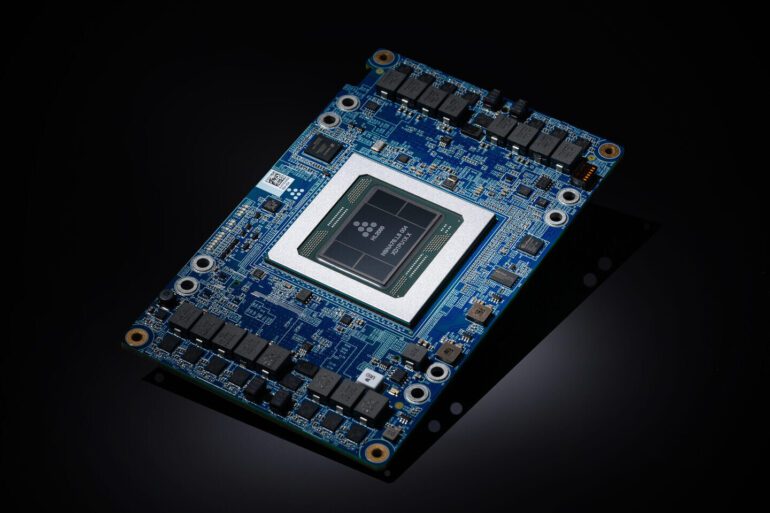TL;DR:
- Intel announces a modified version of its AI accelerator, the Habana Gaudi 2, tailored for the Chinese market.
- Prominent Chinese server vendors, including Inspur, H3C, and xFusion, show interest in selling the chips.
- The Gaudi 2 aims to compete with Nvidia’s A100 GPUs, offering superior performance in image classification and natural language processing.
- US regulations on AI chip exports have made it challenging for Chinese companies to acquire GPUs for LLMs and machine learning applications.
- Intel’s move aligns with Nvidia’s release of China-compliant versions of its A100 and H100 GPUs.
- The Gaudi 2 will require further modifications to comply with Chinese regulations, but specifics remain unclear.
- Intel’s customization strategy reflects its previous efforts to target specific markets, as seen with the GPU Max SKU launch.
Main AI News:
In a strategic move to expand its presence in China, Intel is set to release a tailored version of its AI accelerator, the Habana Gaudi 2. Chen Baoli, Vice President and General Manager of Intel’s Datacenter and AI Group in China, made the announcement during a press conference held in Beijing this week. The introduction of these modified chips has garnered the attention of prominent Chinese server vendors, including Inspur, H3C, and xFusion, who are eagerly looking forward to offering them to their customers.
Originally unveiled in the spring of 2022, the Gaudi 2 was specifically designed to compete with Nvidia’s highly sought-after A100 GPUs, which have become the go-to choice for enterprises seeking to train large language models (LLMs). As a quick reminder, Intel acquired Habana for a staggering $2 billion back in late 2019. The Gaudi 2 processor, built on a 7nm process node, boasts 24 tensor cores, 96GB of HBM2e memory, and 24 100GbE ports.
According to internal benchmarks conducted by Intel, the Gaudi 2 accelerator demonstrates approximately double the performance in ResNet-50 image classification and BERT natural language processing model tests when compared to Nvidia’s A100. Despite these impressive results, the Gaudi 2 has yet to achieve the widespread adoption enjoyed by Nvidia’s GPUs. This could be attributed, at least in part, to Nvidia’s earlier announcement of the H100, which promised performance six times that of the A100.
Adding to the complexity, the United States regulations on the export of AI accelerators, implemented in November, have created challenges for Chinese companies in obtaining GPUs and other chips required for LLMs and other machine learning applications. Under these regulations, chip manufacturers are prohibited from selling processors in China capable of exceeding 600GB/sec of I/O bandwidth. This restriction has had a significant impact on the availability of popular GPUs used in AI and high-performance computing applications, including Nvidia’s A100 and H100, as well as AMD’s Instinct MI250X.
In response to these regulations, Nvidia introduced a reduced-speed version of its A100, known as the A800, with half the memory and approximately two-thirds of the bandwidth of the original card. Additionally, the renowned acceleration specialist unveiled a China-compliant variant of its H100, aptly named the H800.
Today, reports from DigiTimes indicate that Intel’s Gaudi 2 will also require modifications to meet the requirements for sale in the Chinese market. However, the exact changes needed for compliance remain unclear. It is worth noting that the standard chip already falls within the I/O limits. Nevertheless, recent signals from the US government suggest the possibility of even tighter restrictions on the export of AI chips.
The Register has reached out to Intel for comment, and we will provide updates as soon as they become available. It is worth mentioning that Intel has a track record of customizing its chips for specific markets. In April, we reported on Intel’s plans to launch a GPU Max SKU, known as the 1450, which offered lower I/O bandwidth and support for both air- and liquid-cooled systems. The reduced I/O bandwidth led us to believe that China was the intended market, although Intel did not explicitly state this.
Conclusion:
Intel’s decision to develop a customized version of the Habana Gaudi 2 AI chip for the Chinese market signifies its determination to expand its presence in China’s AI landscape. By addressing the specific regulatory requirements and performance demands of Chinese customers, Intel aims to capture a larger market share and establish itself as a formidable competitor to Nvidia in China. This strategic move demonstrates Intel’s commitment to tailoring its offerings to meet the unique needs of different regions and solidifies its position as a key player in the evolving AI chip market.

